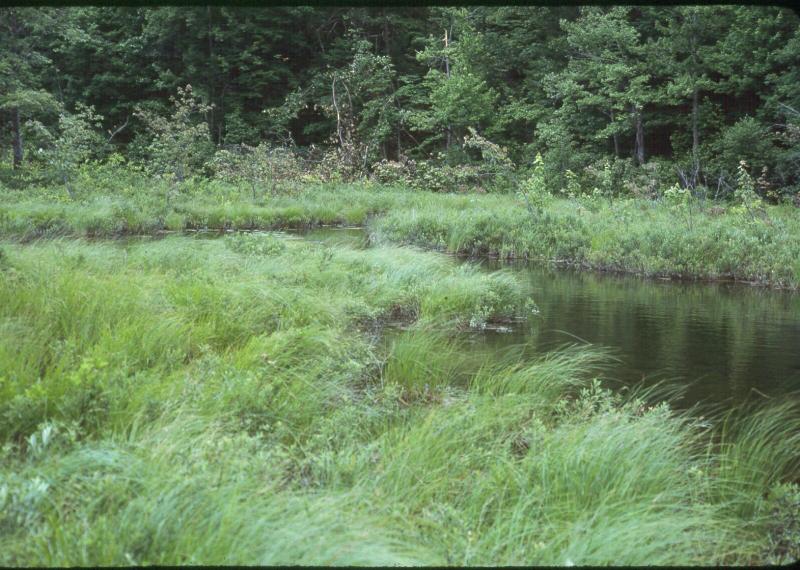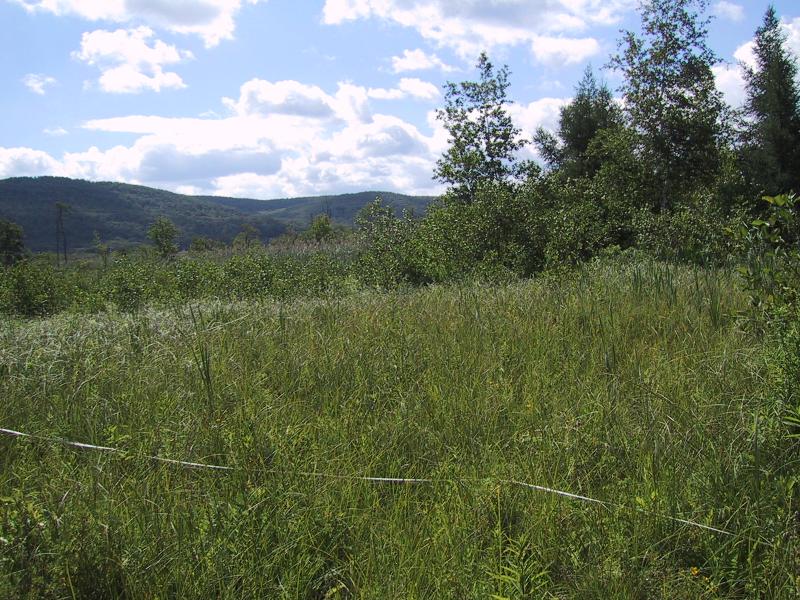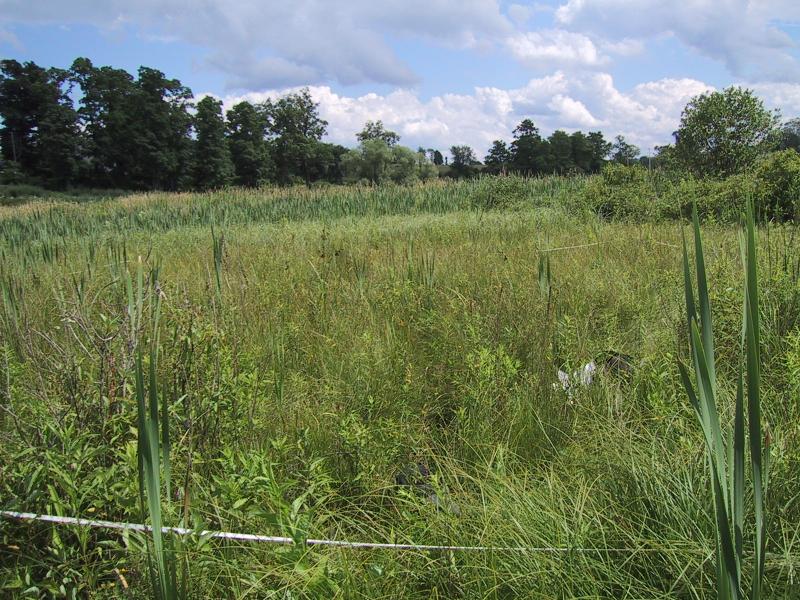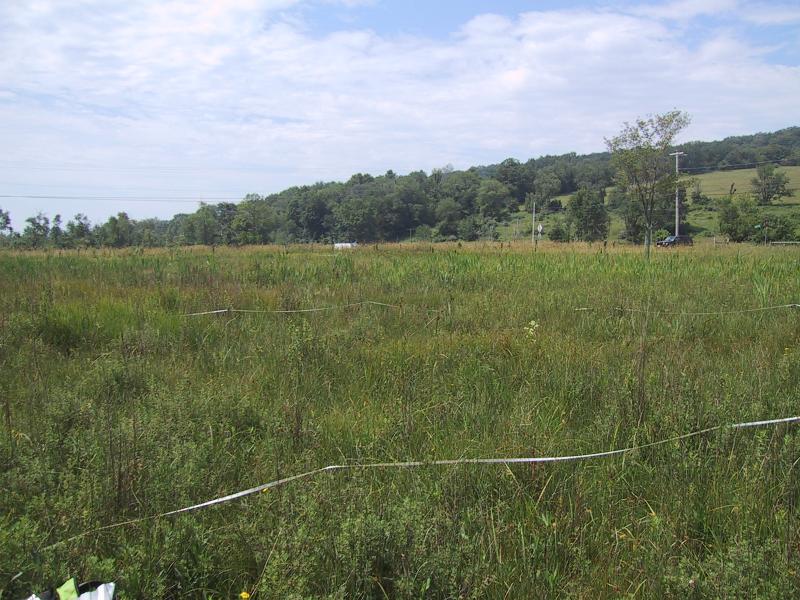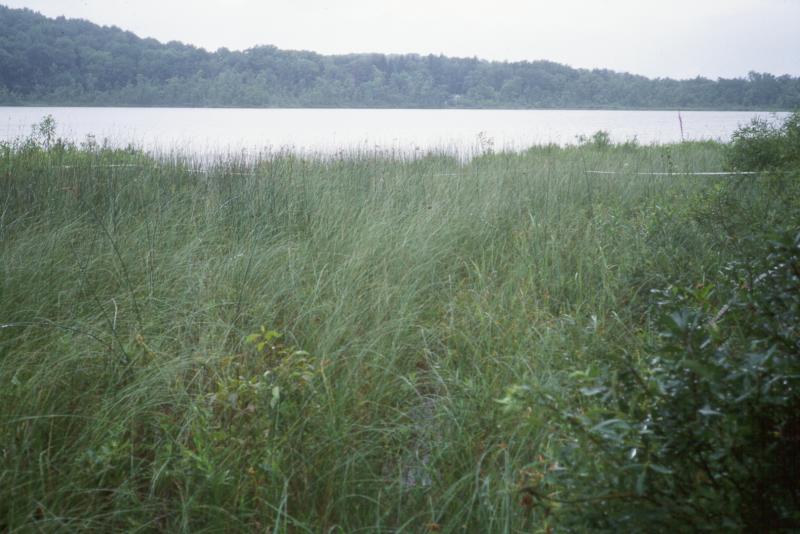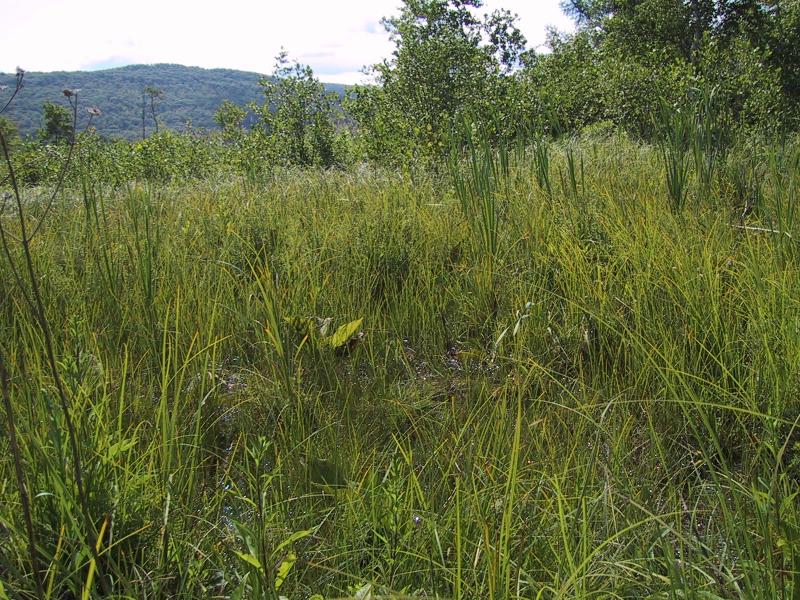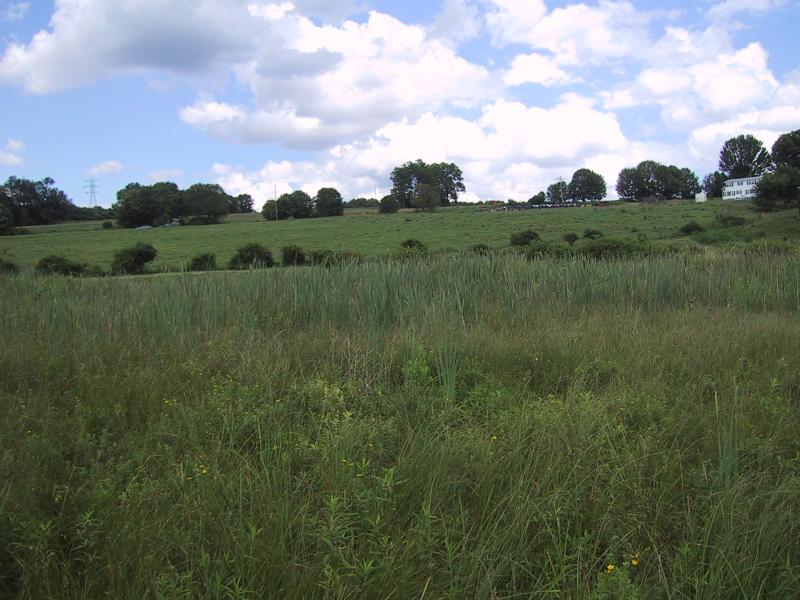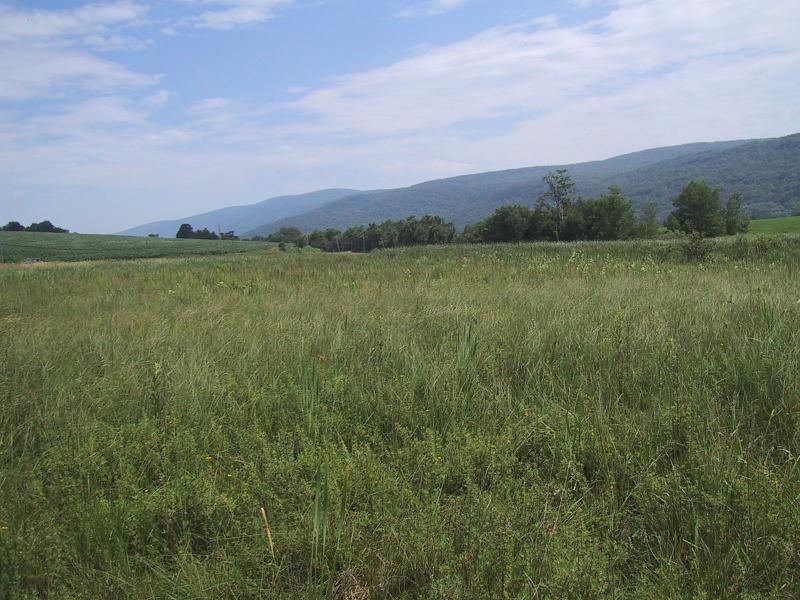Rich Graminoid Fen
- System
- Palustrine
- Subsystem
- Open Peatlands
- State Protection
- Not Listed
Not listed or protected by New York State.
- Federal Protection
- Not Listed
- State Conservation Status Rank
- S1
Critically Imperiled in New York - Especially vulnerable to disappearing from New York due to extreme rarity or other factors; typically 5 or fewer populations or locations in New York, very few individuals, very restricted range, very few remaining acres (or miles of stream), and/or very steep declines.
- Global Conservation Status Rank
- G3
Vulnerable globally - At moderate risk of extinction due to rarity or other factors; typically 80 or fewer populations or locations in the world, few individuals, restricted range, few remaining acres (or miles of stream), and/or recent and widespread declines.
Summary
Did you know?
"Rich" in rich graminoid fen refers to the position of this community on the pH and minerotrophic scales. It has a relatively high pH and groundwater nutrient availability. Rich graminoid fens are also high in plant diversity compared to bogs and poor fens, often having dozens of plant species growing within a 10 m x 10 m sample area.
State Ranking Justification
There are only about fifty occurrences statewide, and the total acreage is very small. Some documented occurrences have good viability and a few are protected on public land or private conservation land. This community is limited to the calcareous areas of the state, and includes a few high quality examples. The current trend of this community is probably stable for occurrences on public land, or declining slightly elsewhere due to moderate threats related to development pressure, invasive plants, and alteration to the natural hydrology.
Short-term Trends
The number and acreage of rich graminoid fens in New York have probably remained stable in recent decades as a result of wetland protection regulations.
Long-term Trends
The number and acreage of rich graminoid fens in New York have probably declined moderately to substantially from historical numbers, likely correlated with the onset of agricultural and residential development.
Conservation and Management
Threats
Rich graminoid fens are threatened by development and its associated run-off (e.g., agriculture, residential, roads), recreational overuse (e.g., ATVs, hiking trails), and habitat alteration in the adjacent landscape (e.g., mining, excessive logging, pollution). In addition, deer over-browsing and heavily used deer trails, and alteration to the natural hydrology (e.g., ditching, blocked culverts, beaver) are threats to this community type. Nearly all examples of rich graminoid fen are threatened by invasive species, such as purple loosestrife (Lythrum salicaria), reed grass (Phragmites australis ssp. australis), buckthorns (Rhamnus spp.), multiflora rose (Rosa multiflora), and several other species.
Conservation Strategies and Management Practices
Consider how water flows around and into this wetland. As most of the water inputs are from underground, management for the prevention of altered water quality and quantity is particularly difficult for this natural community, but it should be of utmost priority. Projects that occur near this community must consider the proximity of the development to this wetland and the potential for changing how water flows, both aboveground and belowground, into this wetland. Terrestrial buffers around rich graminoid fens provide nesting habitat for resident salamanders, frogs, and turtles, and additional food sources for locally nesting birds, and thus should be retained. Consultation with a hydrologist is important to determine patterns of run-off and underground water sources for the wetland; the construction of impervious surfaces, which rapidly deliver water to the system, should be avoided. Rapid influxes of surface water dilute the limey, mineral-rich waters, decrease the robustness of the native fen species, and increase the likelihood of invasion by non-native species.
Development and Mitigation Considerations
When considering road construction and other development activities, minimize actions that will change what water carries and how water travels to this community, both on the surface and underground. Water traveling over-the-ground as run-off usually carries an abundance of silt, clay, and other particulates during (and often after) a construction project. While still suspended in the water, these particulates make it difficult for aquatic animals to find food; after settling to the bottom of the wetland, these particulates bury small plants and animals and alter the natural functions of the community in many other ways. Thus, road construction and development activities near this community type should strive to minimize particulate-laden run-off into this community. Water traveling on the ground or seeping through the ground also carries dissolved minerals and chemicals. Road salt, for example, is becoming an increasing problem both to natural communities and as a contaminant in household wells. Fertilizers, detergents, and other chemicals that increase the nutrient levels in wetlands cause algae blooms and eventually an oxygen-depleted environment where few animals can live. Herbicides and pesticides often travel far from where they are applied and have lasting effects on the quality of the natural community. So, road construction and other development activities should strive to consider: 1. how water moves through the ground, 2. the types of dissolved substances these development activities may release, and 3. how to minimize the potential for these dissolved substances to reach this natural community.
Inventory Needs
Additional inventory efforts in regions with calcareous bedrock and promising wetlands will likely turn up a few additional sites. Re-inventories of known sites will provide important information to help assess short and long term changes. Survey fens that provide habitat for rare species. For example, extant bog turtle sites should be surveyed to determine the type and quality of the natural community if it is unknown.
Research Needs
Research better ways to accurately and efficiently measure and understand the groundwater hydrology of fens. Further research into determining the proportion of fen water inputs is needed (e.g., groundwater vs. surface). If a fen is strongly groundwater influenced, traditional wetland buffers aimed at reducing surface water run-off may not sufficiently protect fen groundwater hydrology.
Rare Species
- Anticlea elegans var. glauca (White Death Camas) (guide)
- Arethusa bulbosa (Dragon's Mouth Orchid) (guide)
- Asclepias purpurascens (Purple Milkweed) (guide)
- Blephilia ciliata (Downy Wood Mint) (guide)
- Calamagrostis stricta (Northern Reed Grass) (guide)
- Calypso bulbosa var. americana (Calypso) (guide)
- Carex buxbaumii (Brown Bog Sedge) (guide)
- Carex capillaris (Hair-like Sedge) (guide)
- Carex garberi (Elk Sedge) (guide)
- Carex livida (Livid Sedge) (guide)
- Carex meadii (Mead's Sedge) (guide)
- Carex sartwellii (Sartwell's Sedge) (guide)
- Carex schweinitzii (Schweinitz's Sedge) (guide)
- Carex tenuiflora (Sparse-flowered Sedge) (guide)
- Castilleja coccinea (Indian Paintbrush) (guide)
- Cirriphyllum piliferum (Hair-pointed Moss) (guide)
- Cypripedium candidum (Small White Lady's Slipper) (guide)
- Fagitana littera (Marsh Fern Moth) (guide)
- Glyptemys muhlenbergii (Bog Turtle) (guide)
- Iris prismatica (Slender Blue Flag) (guide)
- Juniperus horizontalis (Creeping Juniper) (guide)
- Lysimachia quadriflora (Linear-leaved Loosestrife) (guide)
- Myurella julacea (Small Mousetail Moss) (guide)
- Panicum flexile (Wiry Witch Grass) (guide)
- Pedicularis lanceolata (Marsh Lousewort) (guide)
- Poa paludigena (Slender Marsh Blue Grass) (guide)
- Pseudocalliergon turgescens (Curving Feather Moss) (guide)
- Regina septemvittata (Queen Snake) (guide)
- Scleria verticillata (Low Nut Sedge) (guide)
- Sistrurus catenatus (Eastern Massasauga) (guide)
- Solidago ohioensis (Ohio Goldenrod) (guide)
- Sparganium natans (Small Bur-reed) (guide)
- Sphagnum andersonianum (Anderson's Peat Moss) (guide)
- Sphagnum subfulvum (Pale Peat Moss) (guide)
- Symphyotrichum boreale (Northern Bog Aster) (guide)
- Trichophorum cespitosum ssp. cespitosum (Deer's Hair Club Sedge) (guide)
- Triglochin palustris (Marsh Arrow Grass) (guide)
- Trollius laxus (Spreading Globeflower) (guide)
- Valeriana uliginosa (Marsh Valerian) (guide)
- Viola nephrophylla (Northern Bog Violet) (guide)
Range
New York State Distribution
This community is currently known from the Hudson Valley, the St. Lawrence Valley, and scattered locations within the limestone belt that runs from Albany to Niaraga Falls. Additional occurrences may be located elsewhere in the state where similar environmental conditions are present.
Global Distribution
This physically broadly-defined community may be widespread in areas of the United States and worldwide with calcareous peats. Examples with the greatest biotic affinities to New York occurrences are suspected to extend north into Ontario, south to the Central Appalachians of North Carolina and Tennessee, west to Michigan, Wisconsin, and Iowa, east to western New England, and northeast to New Brunswick. Few examples are suspected east of the Appalachian Divide, where the bedrock is mostly acidic.
Best Places to See
- Bonaparte Swamp Preserve (Lewis County)
- Summit Lake Preserve (Otsego County)
- Powder Mill Park (Monroe County)
- Fiddlers Green Preserve (Madison County)
Identification Comments
General Description
A strongly minerotrophic peatland in which the substrate is a predominantly graminoid peat that may or may not be underlain by marl. Rich fens are fed by waters that have high concentrations of minerals and high pH values, generally from 6.0 to 7.8. Rich graminoid fens are usually fed by water from highly calcareous springs or seepage. The dominant species in rich graminoid fens are sedges, although grasses and rushes may be common. Shrubs may be present, but collectively they have less than 50% cover. Peat mosses (Sphagnum spp.) are either absent or a minor component, with only the most minerotrophic species present. Other mosses, especially those requiring highly minerotrophic conditions, may be common.
Characters Most Useful for Identification
Characteristic herbs include spike muhly (Muhlenbergia glomerata), swamp goldenrod (Solidago uliginosa), sedges (Carex flava, C. lasiocarpa, C. sterilis, C. aquatilis, C. prairea, C. hystericina), bog-rush (Cladium mariscoides), grass-of-parnassus (Parnassia glauca), sundew (Drosera rotundifolia), marsh fern (Thelypteris palustris), white beakrush (Rhynchospora alba), common cat-tail (Typha latifolia), spikerush (Eleocharis rostellata), royal fern (Osmunda regalis), blue flag (Iris versicolor), and hard-stem bulrush (Schoenoplectus acutus). Characteristic shrubs include shrubby cinquefoil (Dasiphora fruticosa ssp. floribunda), bayberry (Myrica pensylvanica), speckled alder (Alnus incana ssp. rugosa), poison sumac (Toxicodendron vernix), red maple (Acer rubrum), alder-leaf buckthorn (Rhamnus alnifolia), red osier dogwood (Cornus sericea), and hoary willow (Salix candida). Mosses that can become characteristically abundant in rich graminoid fens are Campylium stellatum and the rare scorpion feather moss (Scorpidium scorpioides). Other characteristic nonvascular species include the peat moss Sphagnum centrale, and the leafy liverworts Calypogeia sphagnicola, Lepidozia reptans, Mylia anomala, and Plagiochila porelloides. Additional rich graminoid fen bryophytes common to other rich fen types include the mosses Aulacomnium palustre, Bryum pseudotriquetrum, Calliergonella cuspidata, Cratoneuron filicinum, Fissidens adianthoides, Scorpidium revolvens, the peat moss Sphagnum warnstorfii, the rare golden moss (Tomentypnum nitens), and the thalloid liverwort Aneura pinguis. Sooty cupola moss (Cinclidium stygium) and pipe-cleaner moss (Paludella squarrosa) are two additional rare mosses that have only been found in rich graminoid fens in New York.
Elevation Range
Known examples of this community have been found at elevations between 335 feet and 1,140 feet.
Best Time to See
One of the best times to visit this community is when the showy yellow flowers of shrubby cinquefoil (Dasiphora floribunda) are in full bloom, usually from mid July to mid August. Rich graminoid fens are also scenic during late summer, when plant species of the aster family come into bloom.
Rich Graminoid Fen Images
Classification
International Vegetation Classification Associations
This New York natural community encompasses all or part of the concept of the following International Vegetation Classification (IVC) natural community associations. These are often described at finer resolution than New York's natural communities. The IVC is developed and maintained by NatureServe.
- (Inland Sedge, Bottlebrush Sedge, Yellow Sedge) - Alpine Bulrush / Star Campylium Moss Fen (CEGL006331)
- Gray Dogwood / (Dioecious Sedge, Water Sedge, Lake Sedge) Fen (CEGL006123)
- Shrubby-cinquefoil / Inland Sedge - Yellow Sedge - Fen Grass-of-Parnassus Fen (CEGL005140)
- Shrubby-cinquefoil / (Dioecious Sedge, Bottlebrush Sedge, Yellow Sedge) Fen (CEGL006326)
- Eastern Red-cedar / Shrubby-cinquefoil / Yellow Sedge - Rigid Sedge Fen (CEGL006357)
- Sweetgale - Shrubby-cinquefoil / Woolly-fruit Sedge - Smooth Sawgrass Fen (CEGL006068)
NatureServe Ecological Systems
This New York natural community falls into the following ecological system(s). Ecological systems are often described at a coarser resolution than New York's natural communities and tend to represent clusters of associations found in similar environments. The ecological systems project is developed and maintained by NatureServe.
- Laurentian-Acadian Alkaline Fen (CES201.585)
- North-Central Appalachian Seepage Fen (CES202.607)
Characteristic Species
-
Trees > 5m
- Acer rubrum var. rubrum (common red maple)
-
Shrubs 2 - 5m
- Acer rubrum var. rubrum (common red maple)
-
Shrubs < 2m
- Cornus sericea (red-osier dogwood)
- Dasiphora fruticosa (shrubby-cinquefoil)
- Salix candida (sage-leaved willow)
-
Herbs
- Carex aquatilis (water sedge)
- Carex flava (yellow sedge)
- Carex hystericina (porcupine sedge)
- Carex leptalea (bristle-stalked sedge)
- Carex pellita (woolly sedge)
- Carex sterilis (dioecious sedge)
- Carex stricta (tussock sedge)
- Cladium mariscoides (twig-rush)
- Drosera rotundifolia (round-leaved sundew)
- Eleocharis rostellata (walking spike-rush)
- Eupatorium perfoliatum (boneset)
- Iris versicolor (blue flag)
- Muhlenbergia glomerata (spike muhly)
- Osmunda regalis var. spectabilis (royal fern)
- Parnassia glauca (common grass-of-Parnassus)
- Solidago patula (rough-leaved goldenrod)
- Solidago uliginosa (bog goldenrod)
- Thelypteris palustris var. pubescens (marsh fern)
- Typha angustifolia (narrow-leaved cat-tail)
- Typha latifolia (wide-leaved cat-tail)
-
Nonvascular plants
- Aneura pinguis
- Campylium stellatum
- Drepanocladus revolvens
Similar Ecological Communities
- Medium fen
(guide)
Medium fens are open, herbaceous or dwarf shrub dominated wetlands. American woollyfruit sedge (Carex lasiocarpa ssp. americana) and sweet gale (Myrica gale) are the dominant species, with leatherleaf (Chamaedaphne calyculata) as a typical codominant or minor associate.
- Rich shrub fen
(guide)
Rich shrub fens have similar species compositions to rich graminoid fens, but the shrub cover is greater than 50%, and the substrate is primarily a woody peat.
- Sedge meadow
(guide)
Sedge meadows are open wetlands dominated by tussock sedge (Carex stricta) with bluejoint grass (Calamagrostis canadensis) as a common codominant. Sedge meadows have less than 50% (and usually less than 25% ) shrub cover. Tussock sedge may be present in rich graminoid fens, but it usually makes up less than 50% cover. Sedge meadows are not as floristically diverse as rich graminoid fens.
Vegetation
Percent cover
This figure helps visualize the structure and "look" or "feel" of a typical Rich Graminoid Fen. Each bar represents the amount of "coverage" for all the species growing at that height. Because layers overlap (shrubs may grow under trees, for example), the shaded regions can add up to more than 100%.
Additional Resources
References
Andrus, R.E. 1980. Sphagnaceae (Peat Moss Family) of New York State. Bulletin No. 442. New York State Museum. Albany, NY.
Cowardin, L.M., V. Carter, F.C. Golet, and E.T. La Roe. 1979. Classification of wetlands and deepwater habitats of the United States. U.S. Fish and Wildlife Service. Washington, D.C. 131 pp.
Edinger, G. J., D. J. Evans, S. Gebauer, T. G. Howard, D. M. Hunt, and A. M. Olivero (editors). 2014. Ecological Communities of New York State. Second Edition. A revised and expanded edition of Carol Reschke’s Ecological Communities of New York State. New York Natural Heritage Program, New York State Department of Environmental Conservation, Albany, NY. https://www.nynhp.org/ecological-communities/
Edinger, Gregory J., D.J. Evans, Shane Gebauer, Timothy G. Howard, David M. Hunt, and Adele M. Olivero (editors). 2002. Ecological Communities of New York State. Second Edition. A revised and expanded edition of Carol Reschke's Ecological Communities of New York State. (Draft for review). New York Natural Heritage Program, New York State Department of Environmental Conservation. Albany, NY. 136 pp.
Godwin, K.S., J.P. Shallenberger, D.J. Leopold, and B.L. Beford. 2000. Linking landscape parameters to local hydrogeologic gradients and plant species occurrence in New York fens: A hydrogeologic setting (HGS) framework. Unpublished draft manuscript. December 20, 2000.
Goodwin, R.H. 1943. The flora of Mendon Ponds Park. Proc. Rochester Academy Sci. 8:233-298.(esp. pp. 243-245).
Motzkin, G. 1994. Calcareous fens of western New England and adjacent New York State. Rhodora. 96(885): 44-68.
New York Natural Heritage Program. 2024. New York Natural Heritage Program Databases. Albany, NY.
New York State Department of Environmental Conservation. 1995. Freshwater Wetlands: Delineation Manual. July 1995. New York State Department of Environmental Conservation. Division of Fish, Wildlife, and Marine Resources. Bureau of Habitat. Albany, NY.
Olivero, Adele M. 2001. Classification and Mapping of New York's Calcareous Fen Communities. A summary report prepared for the Nature Conservancy - Central/Western New York Chapter with funding from the Biodiversity Research Institute. New York Natural Heritage Program, New York State Department of Environmental Conservation. Albany, NY. 28 pp. plus nine appendices.
Olivero, Adele. 2002. Survey of Eastern New York's calcareous fens in the Mount Everett-Mount Riga landscape. A report prepared for the Nature Conservancy Eastern New York Chapter. New York Natural Heritage Program, New York State Department of Environmental Conservation. Albany, NY. 31 pp. plus appendices.
Reschke, Carol, B. Bedford, N. Slack, and F.R. Wesley. 1990. Fen Vegetation of New York State. A poster presented of July 31, 1990 at the Ecological Society of America Annual Meeting, Snowbird, Utah.
Reschke, Carol. 1990. Ecological communities of New York State. New York Natural Heritage Program, New York State Department of Environmental Conservation. Latham, NY. 96 pp. plus xi.
Seischab, F.K. 1984. Plant community development in the Byron-Bergen Swamp: Marl bed vegetation. Can. J. Bot. 62:1006-1017.
Shanks, R.E. 1966. An ecological survey of the vegetation of Monroe County, New York. Proc. Rochester Academy Sci. 11:108-252.
Slack, Nancy G. 1994. Can one tell the mire type from the bryophytes alone? J. Hattori Bot. Lab 75:149-159.
Links
About This Guide
This guide was authored by: Aissa Feldmann
Information for this guide was last updated on: May 16, 2024
Please cite this page as:
New York Natural Heritage Program. 2024.
Online Conservation Guide for
Rich graminoid fen.
Available from: https://guides.nynhp.org/rich-graminoid-fen/.
Accessed July 26, 2024.
